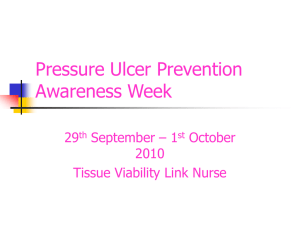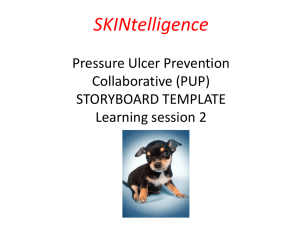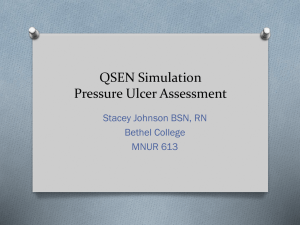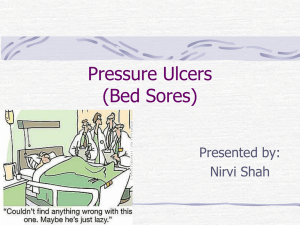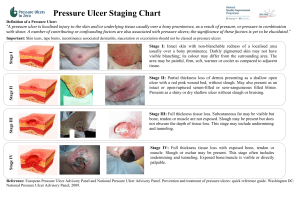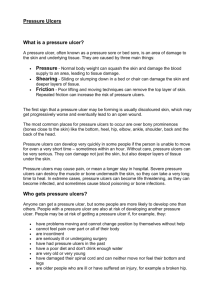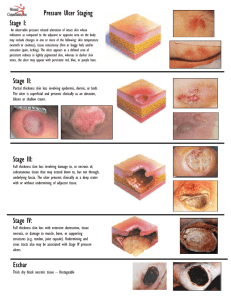Pressure Ulcer Prevention December 8, 2009
advertisement
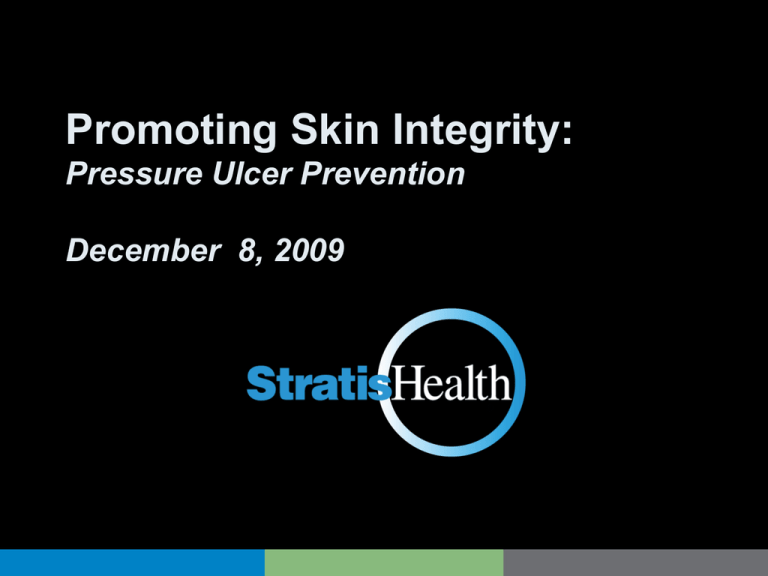
Promoting Skin Integrity: Pressure Ulcer Prevention December 8, 2009 Stratis Health • Stratis Health is a non-profit organization that leads collaboration and innovation in health care quality and safety, and serves as a trusted expert in facility improvement for people and communities • Under federal contract, Stratis Health serves as Minnesota’s Medicare Quality Improvement Organization (QIO) • Stratis Health is also involved in other state and national projects funded through government contracts, foundation and corporate grants, and health systems • www.stratishealth.org Objectives • Recognize the impact a pressure ulcer has on the overall health and well-being of an individual. • Describe key components of a comprehensive skin integrity program. • Share with your organization: – Two practical strategies for implementing a pressure ulcer prevention program – One idea for monitoring your pressure ulcer prevention program to ensure it is meeting the goals of the program • Identify three resources for up-to-date pressure ulcer prevention and treatment strategies. Housekeeping • Packet- includes agenda and presentation handouts • Restrooms • Lunch • Who is in the room? • Meet everyone at your table. What are you hoping to get out of today? • Cross setting efforts – seating arrangements • Resource table WHY ARE WE STILL TALKING ABOUT PRESSURE ULCERS? What Do We Know? • The prevalence of pressure ulcers has remained constant at about 7% over the past 20 years, even though considerable time and money have been invested in various prevention strategies – Whitfield MD, Kaltenthaler EC, Akehurst RL, Walters SJ, Paisley S. How effective are prevention strategies in reducing the prevalence of pressure ulcers? J Wound Care. 2000;9:261-266 What Do We Know? • 1.3 million to 3 million adults have a pressure ulcer. • Estimated cost to heal each ulcer is $500 to $40,000 • The incidence of pressure ulcers varies greatly by clinical setting: 0.4% to 38.0% for hospitals, 2.2% to 23.9% for long-term care, and 0% to 17% for home care • Pressure ulcers in elderly persons have also been associated with increased mortality rates – Lyder CH. Pressure ulcer prevention and management. JAMA. 2003;289:223-226 Personal Story Attitude and culture • Have we normalized the occurrence of pressure ulcers, do we believe they are “just going to happen?” Litigation • Patient safety concerns were triggered following the release of the Institute of Medicine's 1999 report "To Err is Human: Building a Safer Health System." • A recent Congressional investigation demonstrated that nearly 9,000 citations of abuse were issued over 2 years among the nation's 17,000 nursing homes starting in 1999. Among the abuses identified were "untreated bedsores.“ Litigation • The Attorney's Quick Guide: "The 6 Essential Elements of Pressure Ulcers You Must Find in the Medical Record.“ – What every attorney in pressure ulcer litigation must find in the medical record of the acute and long-term care settings, including: • The six elements of a pressure ulcer assessment that must be documented by the nurse • The seven common areas for pressure ulcers to develop • A common documenting gap that kills the defense • 4 Questions that must be asked about infected wounds • What is eschar and how it can delay pressure ulcer healing – http://www.hgexperts.com/article.asp?id=5020 Financial – As of October 1, 2008, the Center for Medicare and Medicaid Services (CMS) no longer pays for the cost of care for a facility-acquired pressure ulcer – HealthGrades, Inc. recently reported that 445,028 pressure ulcers developed in almost 14 million Medicare patients (32 cases/1,000 patients) from 2005 to 2007 and cost $2.41 billion in excess healthcare costs 2009 Annual Report: MN Adverse Events Report Pressure Ulcer Hospital Data* 2008-2009 9 MN is in this group 8 Percent % 7 6 5 2008-2009 4 3 2 1 0 East North East South Central Central Middle Atlantic Mountain New England Pacific South Atlantic West North West South Central Central *National prevalence study performed 2 days in 2008 and 2009- reported as percent of patients that developed a stage 2, 3 or 4 PU while in hospital. High Risk Pressure Ulcer QI Measure Rates by Month 12.00% 11.00% 10.00% 9.00% 8.00% 7.00% All Stratis Health Participants (43) 6.00% All Other Minnesota NHs (excludes the 43 Stratis Health Participants) 5.00% 4.00% Call to Action • “What do our residents/patients expect from us?” – No harm, no pressure ulcers – “You can save my life but cannot prevent a pressure ulcer?” – Working together with a focus on continuous improvement – Wanting those that provide their care to be the best, not just “good enough” Flow of Day • Learn from our content expert about the standard of care and a comprehensive approach to maintain skin integrity • Work together to identify solutions to common barriers • Work together to begin or continue planning our actions and changes Stratis Health is a nonprofit organization that leads collaboration and innovation in health care quality and safety, and serves as a trusted expert in facilitating improvement for people and communities.
